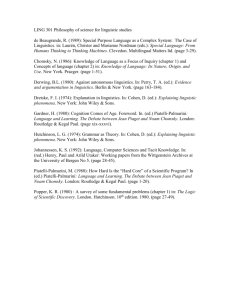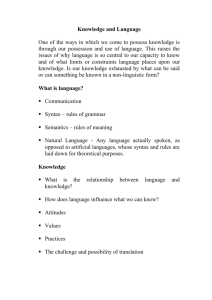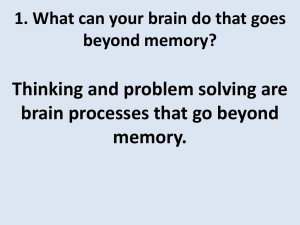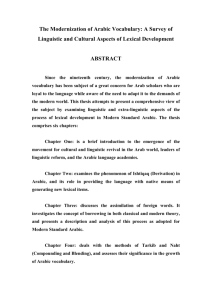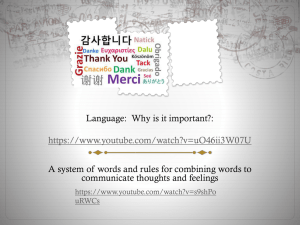Document 10465107
advertisement
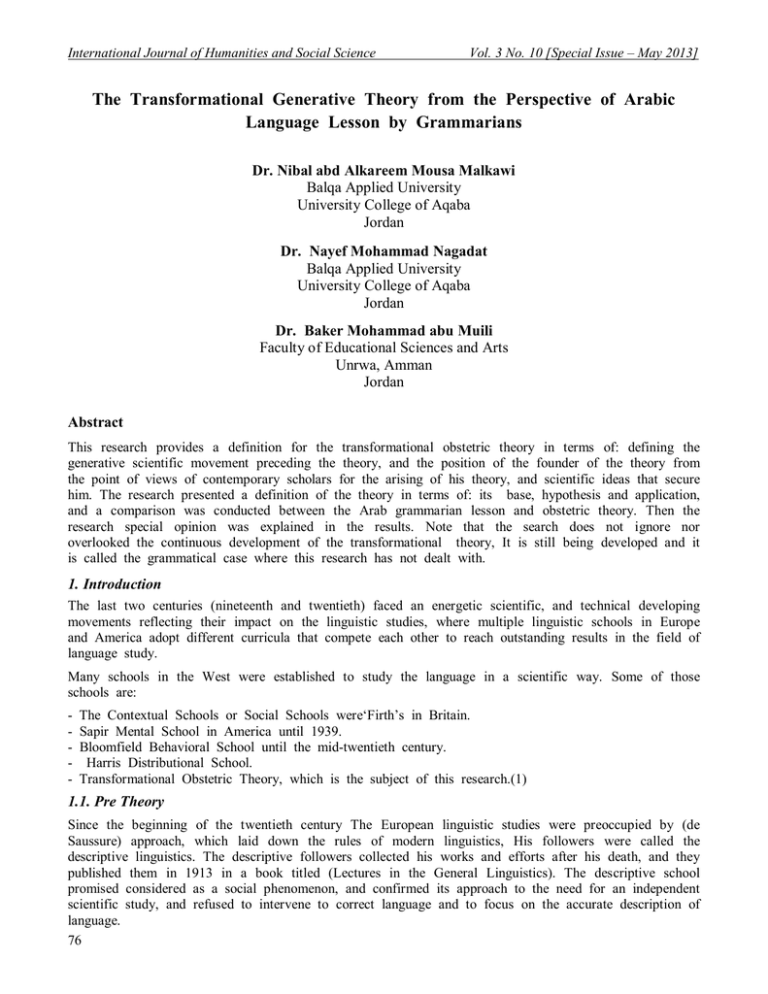
International Journal of Humanities and Social Science Vol. 3 No. 10 [Special Issue – May 2013] The Transformational Generative Theory from the Perspective of Arabic Language Lesson by Grammarians Dr. Nibal abd Alkareem Mousa Malkawi Balqa Applied University University College of Aqaba Jordan Dr. Nayef Mohammad Nagadat Balqa Applied University University College of Aqaba Jordan Dr. Baker Mohammad abu Muili Faculty of Educational Sciences and Arts Unrwa, Amman Jordan Abstract This research provides a definition for the transformational obstetric theory in terms of: defining the generative scientific movement preceding the theory, and the position of the founder of the theory from the point of views of contemporary scholars for the arising of his theory, and scientific ideas that secure him. The research presented a definition of the theory in terms of: its base, hypothesis and application, and a comparison was conducted between the Arab grammarian lesson and obstetric theory. Then the research special opinion was explained in the results. Note that the search does not ignore nor overlooked the continuous development of the transformational theory, It is still being developed and it is called the grammatical case where this research has not dealt with. 1. Introduction The last two centuries (nineteenth and twentieth) faced an energetic scientific, and technical developing movements reflecting their impact on the linguistic studies, where multiple linguistic schools in Europe and America adopt different curricula that compete each other to reach outstanding results in the field of language study. Many schools in the West were established to study the language in a scientific way. Some of those schools are: - The Contextual Schools or Social Schools were‘Firth’s in Britain. Sapir Mental School in America until 1939. Bloomfield Behavioral School until the mid-twentieth century. Harris Distributional School. Transformational Obstetric Theory, which is the subject of this research.(1) 1.1. Pre Theory Since the beginning of the twentieth century The European linguistic studies were preoccupied by (de Saussure) approach, which laid down the rules of modern linguistics, His followers were called the descriptive linguistics. The descriptive followers collected his works and efforts after his death, and they published them in 1913 in a book titled (Lectures in the General Linguistics). The descriptive school promised considered as a social phenomenon, and confirmed its approach to the need for an independent scientific study, and refused to intervene to correct language and to focus on the accurate description of language. 76 The Special Issue on Arts and Social Science © Center for Promoting Ideas, USA www.ijhssnet.com The descriptive approach defined language as: a system of signs and symbols shared by members of the linguistic group, which allows them to communicate with each other. They differentiate between the language and the spoken words that they define as: the individual’s performance of language.(2) Sapir’s scientific efforts were in the field of voices to fill a gap of the descriptive approach; he provided important researches of linguistic sounds which are the language codes and markings that we make. During the descriptive time (Bloomfield) efforts, which criticized the old linguistic studies because they are evidentiary and standard. He was influenced by behaviorists and he explained the verbal behavior as a response due to incentive and he included this trend in his book (language), which was published in 1933. He believed that the study of language must be descriptive and inductive. Bloomfield built his theory by describing the learning of two monkeys of chimpanzees (Washoe, and Sarah) and they have shown a kind of creative usage of language. The teaching method was based on (conditional education) of behavioral which would be to provide an incentive and then show the desired behavior in his education in which learner will imitate and repeat the stimulus and response until he proves the behavior of the learner. Bloomfield believes that responses (the language in this experiment) can be predictable. He also believes that the study of human language must be interpreted in conditions of tutorial (stimuli and response), and he gave a simple example that illustrates conditional learning in human learning of language; the example says: while (Jack) and (Jill ) were walking (Jill) felt hungry, she saw an apple on the tree, she asked Jack to bring it and then she ate it. The behavior of Jill was feeling hungry then noticing the stimuli which is the apple, and finally the linguistic behavior of demanding.(3) Chomsky was studying the language according to Bloomfield behavioral approach of the studying of language. Chomsky directed most of his criticism to the behaviorism, because the monkeys learning of the systems of communication is different from human learning, and this difference is in the quality. Chomsky agreed with the school of mentalist which believes that the human mind is the way of knowledge. Descartes is a mentalist who believes that the most important difference between humans and animals is in the mental activity, which is clear in the human capacity of language, and the inability of animal for that.(4) Chomsky differentiates between animal language and human in terms of ability and learning; so animals learn language by incentives and don’t create the language, and human learn language by innate ability and creativity.Behaviorism has been rejected by (Chomsky) who believed that it was based on prior knowledge of the stimuli from the individual response , and thus the prior knowledge of the expected behavior won’t be considered as expectations because of determining the stimuli, so the issue is not predictable.(5) 1.2. The Basis of the Theory The features of Chomsky's theory started to be formed, which were includes in his book (Syntactic Structures) that was issued in 1957, and met with his supporters from scientific linguists. A number of them started to develop it. the ideas of Chomsky were a new way to find a general theory coming from the direction of the mind, and by creating holistic system that shows structures of sentences in the language(6). Linguistics was considered a branch of cognitive psychology.(7) He discovered the possibility of placing a series of rules ranked in a logical arrangement, and through all this he can explain a lot of language phenomena.(8) The necessary start to build this overall perception was to specify the definition of language which he saw as: all sentences generated by the language studied. He believes that the sentences of language are unlimited in number and endless. So the speaker can compose a long and not ended sentence like: "This is the man that married the girl that ......... It can be assumed that the number of words in the language are limited, and that the speaker does not need all the words of the language, and so there are active words and passive words.(9) 77 International Journal of Humanities and Social Science Vol. 3 No. 10 [Special Issue – May 2013] Chomsky believes that the rules that govern a number of sentences are limited. The speaker can use certain and limited rules to form unlimited sentences, and this necessarily means to use the same rule more than once, and these repeated rules are also limited in number.(10) It is worth mentioning that the theory did not arise full once, but passed in several stages and the founder of it "Chomsky" continued in developing it, as well as the contributions of his followers. It started with the obstetric theory and then it was developed to the transformational theory when he felt that the first one became weak, which was constantly developing and this is one of the factors for the continuity of its impact. 1.3. Hypotheses of the Theory Benkirane believed that the theory of Chomsky was based on two hypothetical questions; first: "How can human beings reach multi knowledge in spite of its limited contact with the world? And the second question: How can the study of language contribute to our understanding of human nature?", he added, "from these questions many questions and answers occurred and they produced the obstetric project."(11) The questions of the theory - by Benkirane – link between basic themes in the process of linguistic communication including the understanding of the diversity in the human nature limited by language. The theory has a number of key assumptions, they are: 2. The Innateness of language The child acquires his language by his innate mental and linguistic wealth that grows by the development of age and gains his implicit rules in the seventh year and can produce unlimited sentences. The school's role is limited in teaching how to read and write. This idea is found at the Descartes (d. 1650), who believes that humans differ from that animals because They have a mind. The German Humboldt (d.1825) states: language is the production of mind. (12) The idea of an innate language emphasizes the rationalism of the human kind. This is because language is a product of the human mind, which is not found in other creatures. The Arab thinkers discussed the rationality of language early. This thought is clear in the interpretation of the words of God in the Holy Quran:" He taught Adam the names all" (اﻟﺒﻘﺮة25), Altoqivuon depends on this verse in considering language as a gift of God to all humanity.(13) 2.1. Linguistic wholes and diversity of languages Languages are woven(14) of a single substance, some of it are shared and others are changeable and the researchers role is to discover them. Chomsky mentioned three types of language faculties: * Core whole: A set of installed categories taken from language-specific elements such as noun, verb and adjectives that all language categories share. Also the phonology of special vocabulary * the apparent whole: are the conditions, regulations or laws shared between languages. * Regulatory whole: How you would organize the rules of each level of language, and deal with the properties of laws that consist grammar, but Chomsky believes that the innateness that enables human language acquisition of natural language is based on the whole rules in the mind of every human being and it a is holistic action regarded human beings. We can also fill it during the acquisition of the language from the family and society.(15) and when the linguistic gains increase, the internal overall regulatory rules also grow in mind. So the ability in humans to generate and build sentences will be controlled by rules and laws called obstetric rules. Perhaps what distinguishes the human beings is the unique existence device of pronunciation which are one in all members of the human community, and this device enables the individual to pronounce the sounds of language according to its own regulations which is inherent in the Mind. Students in each language can define the terms in that they think they will help in understanding the language. 78 The Special Issue on Arts and Social Science © Center for Promoting Ideas, USA www.ijhssnet.com Arab grammarians divide the word into three categories (classes) noun, verb and letter. And made installation within nominal form like: Zaid is coming, and within actions about: Zaid came, and a phrase like: from the market and in the afternoon, and added some wholesale vehicle, a phrase: the conditionals, and the swear, and the appeal, and so on.(16) 2.2. Grammatical Rules They are the norms(17), which aim to preserve the assets of correct language, which is based on standards and aesthetic criteria, but the speaker has implied rules he is not bound by the normative rules nor does they describe the work of the linguistic real process to speak, and doesn’t link between the meanings of mind and speaker’s sounds that he utters. John Lyons says: It's like a device of some kind that can generate all the sentences in the language, which is not limited(18). The grammatical rules are of two levels: the correct level and the incorrect level. Those who speak English will accept a sentence like: the house will have been built, whereas a sentence like: the house will have been being built, is not accepted. These ideas raise two principles: competence and performance. These are the two main elements of the theory(19) that we are going to explain. 2.3. Linguistic Competence or Ability It means the underlying linguistic potential of the individual, which is the ability to produce a large number of sentences by a limited number of votes and show this potential with what is known in the deep structure theory. They are linked to him with Significance :( 20) 5 - Performance which means what humans really produces in the forms of sounds that speech, which is the actual translation of efficiency or capacity represented in the (surface structure) studying the performance or surface structure provides an explanation of the sound in the language, and the studying of efficiency, capacity or the deep infrastructure provide semantic interpretation of language, and because of the importance of performance came the concentration on grammar in the obstetric theory, so this theory focuses on the linguistic ability of the speaker, rather than his actual performance, language and the ability of the speaker due to the fact of mind.(21) While the theory of Chomsky raises ideas in which Arab have discussed, they collected linguistic material and analyzed it, extracted rules, and alerted to the importance of sound and discussed terms ;Alkhalil bin Ahmed in his dictionary (alayen) reached the idea of (Altkulaibat), he encounted with words which are used and with those neglected. Ibn Jenny and other grammarians talked about the adverbs and how they explain the meanings; including accompanying words of the speaker about likem toning, rhythm and body language.(22) 3. Theoretical models 3.1. Formal language Chomsky was affected by math logic in this area, by developing absolutes, laws, derivative; which allow derivations, issues emanating from absolutes, The issues are language sentences, absolutes and the laws are the rules. The developing in this direction has been driven by the need to translate automatically, which began in 1949, for the transfer of scientific books and the requirements of this translation determine the language units of the speaker mediated forms of mathematical and logical shapes, and then passed into the machine, and thus began thinking to select the language of form. and the formal rules by selecting the wholesale fundamentalism in the language, and the correct possibilities to generate them to accept automatically, and identify possibilities rejected linguistically for refusing automatically. For example the sentence: “the man ate the food at home”: is an inter fundamentalist acceptable, and generates about several acceptable forms. But the rejected Figure is: “eating man food home in it”, and the theoretical models formed from the linguistic formalism the model of Almarkovi, and the Corner transformative model.(23) 79 International Journal of Humanities and Social Science Vol. 3 No. 10 [Special Issue – May 2013] Correspondence with latest idea in Arabic grammar what Sebojh said about corruption because of the sentence is corrupted in is meaning like: I drank the stone; the sentence is correct in terms of installation (subject, verb ,object),but corrupt in terms of meaning; since the stone can’t be drunk.(24) 3.2. The Almarkovian Model Chomsky believes that this model is able to confer formality to include obstetric linguistics that” Albonianiah” incapable of distinguishing between the Corner and Font substitution, "Model explains the mechanism by which language works, or rules for obstetric sentences, according to the model of Almarkovi" generous The sentence is lead by the arrows to the formation of the following sentences: 1. The boy became clever. 2. The boy became generous. 3. The man became clever. 4. The man became generous.(25) Perhaps the world's attention to automate language after World War II is the motivation for such a link bin language - any language - and mathematical logic; terms of composition, and a statement possibilities of expression, and disclosed under the pressure of the increasing demand for translation and interpretation.(26) 3.3. Obstetric Rule: (the Corner Model) It was known as the analysis to return direct to literature: it is interested in the mechanism of language from the human linguistic adequacy and the obstetric sets of the maximum number of strings that might exist in the language and building models for it. The obstetric gives the information needed to generate all the correct sentences and to prevent generating incorrect sentences. It was built on the student’s way to analyze the constituent elements of a sentence, and bring the icon instead of studying them, mostly sentence elements are made up of: the verb, the noun ,the definition letters. The sentence is of two types: - Nominal phrase, consisting of: one nominal + another nominal+ physical part or a phrase. - An actual sentence, consisting of actual part + (+ name) + clause + .. The actual sentence can be represented as follows s = ap + sm.”s’ stands for sentence and “a p” symbolizes the actual part, and’ sm’ symbolize semi-sentence. “The man came from the market” can be analyzed as follows: = Came =ap / the man = dehnile + name /from = preposition / the market = definition + name. Then (Chomsky) saw that this model has weaknesses, and so he called for a complete transformational model.(27) 3.4. Transformational rules The concept of transformation depends on the rearrangement of the elements of the sentence to explain the relationship between them .When a sentence comes on more than one picture, they give one meaning no matter how many pictures they mutant show because they come from the same basic syntax found in the deep structure. Consider the following sentences: 1) the man ate the apple 2) the man was eating the apple 3) the apple was eaten by the man - we find that these are multiple images for the same sentence:(28) 80 The Special Issue on Arts and Social Science © Center for Promoting Ideas, USA www.ijhssnet.com 4. Grammar Analysis The use of transformational rules in theory rather than grammar is due to the fact that grammar can be used only in the literary language and the transformational rules could explain the presence of two sentences which are correct grammatically and synonymous in meaning, despite the variation in apparent installation, such as: the boy ate the apple and ate the apple from the boy. And the reason for double a joint installation mystical sentences. And the first installation it is used in the Arabic language, the second installation: I ate the apple from the boy, is not correct in the Arabic language. And the speaker is incorrect, the specificity of the system installation in Arabic sentences is related to the link between structure and meaning, on the one hand and the system of the uncontrolled relevant sentence ascribed to it and the entry, and this advanced offset sentence in Arabic boy ate the apple.(29) Obstetric theory takes a number of ways to analyze the components of the sentence:(30) The first way: finite \ state \ grammar It means the specific rules: there is a kind of choices necessarily mean a specific choice. When we say in Arabic: the man is coming and men are coming. The choice of speaker for single word (man) force him rule language to choose (coming), while if he chooses to combine (coming). The second way: phrase structure Any installation phrases, or syntax; Each phrase consists of basic elements as standard grammatical rules. According to Chomsky to know math is necessary to convert these rules to scientific capacity in mathematics: Q (r * 6) differs from Q (r + 6). The third way: as transformative: transformation It is by analyzing the deep structure and its significance and the surface structure and components which are more comprehensive than the second method to include helping verbs crisis and the combination ... Chomsky has taken into account: This method is based on deletion and replacement and expansion and the shortcut and increase rules and re-arrangement of what is known in the Arabic language and introduce the following laws when Chomsky was trying the representation of the Arabic language as follows: And can be represented in Arabic like: as a n answer for the question; A. Who came? Answer: Zaid. B. Where is Zaid? The answer: he came; In answer to a sentence - (Zaid) Delete (came) any component (A) In the answer sentence - (came) deleted Zaid (B). The answer of this question is not as stated, it is not valid at the origin of installation, by saying: he travelled or is found or something like that, by appreciating the deleted and theoretical treat text like the one shown and did not take the deleted of speech, which is estimated by the listener without trouble in understanding the text. The deleted when Arabs is existing or in the existing rule. Indeed, deletion represents a high degree of fluency in speech.(31) 2. Substitution rules: A = B which means that any item can replace another item, came Zaid or a neighbor man. The big difference between the two sentences is that the first is known and the second is unknown.(32) 3. Expansion rules: A = B + C about: The Abu Amr Zaid bin Said. Where (Abu Omar) is Zaid bin Said and clear in the disciples and interpretation, redundancy, and other doors. In terms of the rules of English there is a big difference between the abstract name (Zaid) and said his nickname raise the offered.(33) 4. Shortcut Rules : A + B = C the poet says: We are what we have, and you are satisfied with what you have ,and the opinion is different(34) 81 International Journal of Humanities and Social Science Vol. 3 No. 10 [Special Issue – May 2013] Arab language owned the property of brevity and economy of words and structures, in order to serve both the speaker and the receiver, from this we say: if you study you will succeeded, and if not you will not; the structure: if not; the deletion of two strings constitute inter reaction condition and inter Answer condition, and by slurring we say: about what the lecturer is speaking?; the origin of what and where are similar between Noon and Meem the voice Almim then Adgma view of the economy in the muscular effort.(35) 5. Increasing rules: A + B = A about: Zaid was cute. The increase in the Arabic language is only for the changing in meaning, then it be the increase in the absolute sense.(36) 6. Reordering rules: A+ B = B+A about: Zaid the generous and the generous Zaid Such sentence in Arabic is only for the benefit of the meaning. The actor in: Zaid writes nominal sentence indicates knowledge Zaid to write, but writes Zaid; verbal sentence indicates that the event is now writing, and there is a big difference between those involved.(37) 5. Arabic Grammar and Obstetric 5.1. Aspects of the Agreement (1) The theory obstetric is similar in assets as assets in terms of the adoption of Arab sections of the wholesale form Almarkovi and obstetric models. There is convergence of ideas in rational language, and distinguish human language, and the similarity in the attention to the principle of intuitive language, a language related to the production creatively.(38) (2) The deep structure of grammarians resorted to the appreciation and interpretation because of the theory which assumes omitted factor that speaker did not say, to solve problems expressed in the number of many sentences.(39) (3) The direction of the theory in the phase transformation to the gates of Arabic grammar came to solve problems encountered in the interpretation of many of the issues of language (such as expansion and deletions, and increase and re-order), it has proved see Chomsky as Arab, and influenced by some principles.(40) (4) The observers of the theory of the ideas ideas and the origin Arabic grammar do not exclude the impact of the theory on Arabic grammar, the founder of the theory studied Hebrew, it is necessary to keep the post as Arab, because Hebrew studies were based on Arab. 5.2. Aspect of the difference (1) Chomsky focused on finding a theory that solves the problem of automating language, so came the ideas of his theory - before the grammatical case - interested as linguistic, while Arabs were interested in finding studies that can help him to understand the meaning of texts, and facilitate language learning, so was his view of the language of comprehensive It takes into account both the pronunciation and meaning, and the relationship between them in the superficial and deep structures. (2) the idea of ranking: Chomsky believes that the clause about: Prophet was equal in meaning message: The message of the Prophet and also equal to the message reached the Prophet. And neglected by the meaning derived from the presentation, it was the Arabs care if she wanted something in the sentence provided.(40) (3) increasing when manufacturing is to improve the structure of the surface, there is no trace of her in the deep structure. Arabs say: every change in the building leads to a change in meaning, and Arabs were interested in the studies of Arabs linguistic sense rhetorical level sentence, meaning contextual meaning that Jerjani has called term foundries, text come from coherence of words with meanings.(41) (4) In Arabic grammar the origin is branched into originally new independent origin, and in chomsky returned it to the original.(42) 82 The Special Issue on Arts and Social Science © Center for Promoting Ideas, USA www.ijhssnet.com (5) Chomsky didn’t care about the cessation and initiation in the language, the two separation and communication to speak, we find as the Arab cares for them, and determines based on the Getting Started string type, determines based on the separation end of the sentence, and the intended sentence predicate, and related accessories, and ties in the context.(43) (6) Arabic sentences are two types: simple installation nominal sentence, and the actual sentence, and complex sentence like; conditional sentence, and section, and others.(44) 6. Results of the study This study is on the theory of transformational obstetric. it became clear to me from contemporary studies in both its author and translator have come to the following ideas: 1. the theory of Chomsky is not suitable for the substitute of Arabic grammar in linguistic studies, Arabic grammar offers more understanding of the relationship between the parts of a sentence, and built a deeper perception of the impact of linguistic systems: voice and morphological and semantic. 2. The linguistic theories, and non-linguistic, stand by the above convincing explanations of the public phenomena, and provide solutions firm for emergencies, and I think that the language of the constructor theory, too, have a role in the strength of the theory itself and durability; therefore the theory of linguistic modern arise from about Arabic language will be the same specifications distinct Arabic language of their excellence the makings of such a big role, and that much of what we hear today of ideas is a product of scientists Arab veterans, but organized a new framework, and confused ideas formality many, led to a distortion of the updated version them. References Mr. Chomsky, pp. 21 - 22 John Lyons, Chomsky's theory pp. 64-65 and 255 -256 John Lyons, Chomsky's theory pp. 69 and 256 Previous 256 Mr. Chomsky pp. 56-57 Previous p.45 Lyons, 207 Previous p.45 John Lyons, Chomsky's theory pp. 94 - 96 Alsbak p. 96 Benkirane, Caliph philosophical theory obstetric 46 Zakaria, linguistics p.133 Al-Salhi, Studies in Philology, 33-34 Zakaria, linguistics, pp. 236 - 264 Amayreh, obstetric theory p.37 Ibn Hisham, Labee 0.364 to 367 Zakaria, linguistics p 201 John Lyons, Chomsky's linguistic theory p88 Amayreh, in some language p 57 John Lyons, Chomsky's linguistic theory p 183 Kholi, rounding rules (p. 25) I'm taking, properties, 1/217, Nihad Mousa, the theory of Arabic grammar,95 Michel Zakaria linguistics pp. 92-96 Sebojh, writers, 1/26, and consider: Suyuti, the proposal, 88 and Jerjani, signs of miracles, 526 Zakaria, linguistics p 90 John Lyons, Chomsky's linguistic theory p 110-111 Michel Zakaria, linguistics p. 96 Alsbak p 101 John Lyons, Chomsky's linguistic theory pp. 111-112 83 International Journal of Humanities and Social Science Vol. 3 No. 10 [Special Issue – May 2013] Al-Rajhi, Arabic grammar pp. 127-141, see: Amayreh, in some language pp. 178-201 and Kholi, rounding rules pp. 28 - 29 I'm taking, features 1/86 Arabs dispersed between knowledge and indefinite article, they made indefinite article is originally because they are less meaningful than knowledge as the indefinite article on the meaning of one and indicate the pan, Ibn Hisham, explain gold nuggets p. 84 Jerjani, Secrets of Rhetoric, 102 House to Qais Ben Alkhtim, in his office extension 239, and said: Sebojh, 1/75, Ibn Hisham, Labee 622, and explain Ibn Aqil 1/125. I'm taking, properties, 2/222, and Kdakd chapter entitled: courage Arab saying: "I know that most of it but it is a deletion and increase the application and delay and the load on the meaning and distortion. Deletion had been deleted Arabs wholesale and retail, crafts and movement., Not None of that except for evidence. "I'm taking, properties, 2/222 Jerjani, Secrets of Rhetoric, 102 Jerjani, Secrets of Rhetoric, 102 I'm taking, properties, 1/77 and the glass, illustration, 95, and others. Al-Salhi, philology, pp. 172-178 Nihad Mousa, Arabic grammar theory pp. 54-56 Amayreh, obstetric theory p. 44, and seen the door of the most important bug in: Nagadat, grammatical malady, pp. 144-145 Suyuti, likes and isotopes 1/294 Mustafa, revived as 50 and seen: Samurai, meaning as 1/169 Ibn Hisham, the singer from 0.367 to 369 Jerjani, Abdalqahir, signs of miracles, achieving Mahmoud Mohamed Shaker, i 5, Khanji library, Cairo, 2004 I'm taking, properties, achieved by Abdul Hakim bin Mohammed Library Commons (d. I) (d.T.). John Lyons, Chomsky's theory of language, translate my dream Khalil, House of Knowledge Alexandria university, i 1, 1985. Kholi, Muhammad Ali, rounding rules of the Arabic language, Dar Mars, Riyadh i 1 1981 Al-Rajhi, Abdo, Arabic grammar and modern lesson, Dar University Press, Alexandria, 1988. glass, clarification as ills achieve Mazen Mubarak, i 4, valuables House, Beirut, 1982. Zakaria, Michel, tongues Modern Linguistics, the university institution Beirut i 2 1982. Samurai, Fadel Saleh, meaning as, i 2, Dar Al-Fikr, 2002 Sebojh, Abu humans Osman bin Qanbar, the book, i 1, House Beirut generation, achieve Mohammed Abdul Salam Haroun, 1991 Mr. Sabri Ibrahim, Chomsky linguistic thought and its critics, House of Knowledge University, Alexandria, Egypt, 1989 Mr. Abdul Rahman, a school of Basra grammatical, i 1, Knowledge House, Egypt, (DT) Suyuti, Nazaa'im as achieved by Mohamed Abdel-Qader al-Fadhli, i 1, modern library, Beirut 1999. Suyuti, the proposal in the science as assets, achieve Mohammed Hassan El-Shafei, i 1, World Library, Beirut, 1998. Ibn Aqil, Bahaa El Din Abdullah bin Aqeel (d. 769 AH), explain Ibn Aqil, Mohammed Mohiuddin achieved Abdul Hamid, Dar Al-Fikr, Beirut, 1974 (d. I). Mustafa Ibrahim, reviving as, Commission Press authoring, translation and publishing, Cairo, 1959. Mousa, Nihad, Arabic grammar theory in the light of modern linguistic approaches to consider, i 1, the Arab Institution for Studies and Publishing, 1980. Naif Nagadat, grammatical malady in the light of the Arab community norms, Ph.D. thesis, University of Mutah, 2004. Ibn Hisham, Abu Muhammad Abdullah Jamal al-Din al-Ansari (d. 761 AH), Labee wrote Aloarab, achieved: blessed Mazen Mohammed Ali Hamad, i 1, Dar Al-Fikr, Lebanon 1998. Ibn Hisham, explain gold nuggets, achieving Abdul Ghani Daker, i 1, United Company, 1984. Benkirane, Ahmed Al-Tayeb, philosophical background in theory obstetric World magazine idea, 25 p 3 3 / January / March 1997. Amayreh Khalil, obstetric theory and its origins in manufacturing as Arab, Arab Journal of linguistic studies / 4 / p 1 / August / 1985 84
